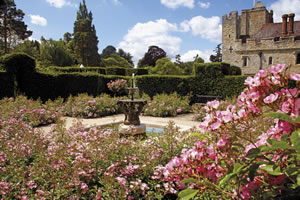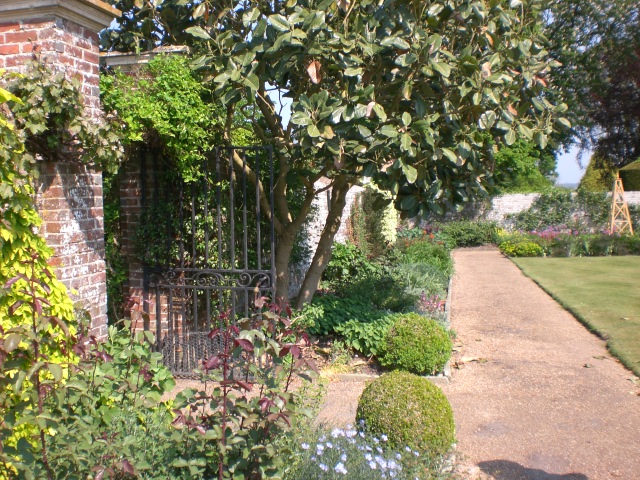





List of Gardens
Click on a garden name to bring it to the top of the page.
- Belmont, Faversham
- Bishopscourt, Rochester
- Chartwell, near Westerham
- Chevening, Sevenoaks
- Chiddingstone Castle, Chiddingstone
- Chilham, Chilham
- Cobham Hall, Cobham
- Court Lodge, Lamberhurst
- Doddington Place, near Sittingbourne
- Eastgate House, Rochester
- Emmetts Garden, Ide Hill
- Godinton House, Ashford
- Goodnestone Park, Wingham
- Great Comp, St Mary's Platt
- Groombridge Place, Tunbridge Wells
- Hever Castle, Edenbridge
- Hole Park, Rolvenden, near Cranbrook
- Knole, Sevenoaks
- Leeds Castle, Maidstone
- Marle Place, Brenchley
- Mere House, Mereworth
- Mote Park, Maidstone
- Mount Ephraim, Faversham
- Officers' Terrace, Chatham
- Penshurst Place, Penshurst
- Port Lympne, near Hythe
- Restoration House, Rochester
- Riverhill Himalayan Garden, Sevenoaks
- Rochester Cathedral Precincts, Rochester
- Scotney Castle, Lamberhurst
- Sissinghurst Castle, near Cranbrook
- Squerryes Court, Westerham
- Vinters Park, Maidstone
 Historic Gardens
Historic Gardens
Hever Castle, Edenbridge
 Best known as the childhood home of Anne Boleyn, the award-winning gardens at romantic Hever Castle in Kent were created by William Waldorf Astor at the turn of the 20th century. Designed to showcase Astor's unique collection of ancient Greek and Roman statuary acquired while he was American Ambassador to Italy, they were laid out between 1904 and 1908 by Joseph Cheal and Son, turning marshland into spectacular classical and natural gardens.
Best known as the childhood home of Anne Boleyn, the award-winning gardens at romantic Hever Castle in Kent were created by William Waldorf Astor at the turn of the 20th century. Designed to showcase Astor's unique collection of ancient Greek and Roman statuary acquired while he was American Ambassador to Italy, they were laid out between 1904 and 1908 by Joseph Cheal and Son, turning marshland into spectacular classical and natural gardens.
There are many water features around the gardens including Half Moon Pond, the Cascade, the cool and shady grottoes and the formal Loggia fountain which overlooks the 38-acre lake. Other areas include the Tudor Garden, Rhododendron Walk and Anne Boleyn's orchard with its collection of trees planted more than 100 years ago, as well as the Yew Maze and Water Maze.
The quintessential English walled Rose Garden contains over 4,000 fragrant roses, planted in blocks of colour from palest pink to deep crimson and rich purple. Varieties range from the Alba and Bourbon to Hybrid Tea and Floribunda.
Hole Park, Rolvenden, near Cranbrook
 The 18th century house, surrounded by over 200 acres of parkland, is set within 15 acres of formal and informal gardens overlooking the picturesque Kentish Weald. The formal enclosures and magnificent yew hedges date from the early 20th century and are similar to those at Godinton. The gardens provide colour throughout the seasons with carpets of bluebells and daffodils in spring as well as wonderful displays of camellia, magnolia and wisteria. In summer, the long borders filled with herbaceous and exotic plants come to life, and in the autumn a variety of woodland trees provide another colourful display.
The 18th century house, surrounded by over 200 acres of parkland, is set within 15 acres of formal and informal gardens overlooking the picturesque Kentish Weald. The formal enclosures and magnificent yew hedges date from the early 20th century and are similar to those at Godinton. The gardens provide colour throughout the seasons with carpets of bluebells and daffodils in spring as well as wonderful displays of camellia, magnolia and wisteria. In summer, the long borders filled with herbaceous and exotic plants come to life, and in the autumn a variety of woodland trees provide another colourful display.
Knole, Sevenoaks
The magnificent Knole house, built more than 600 years ago as an archbishops' palace and gifted to Henry VIII, is now in the care of the National Trust. It is surrounded by Kent's finest Tudor deer park, a forerunner of the great English 18th century landscape park. It has been described as ‘neither sublime nor picturesque. It is, however, especially in the distant view, authentic, looking almost exactly as it did in the year Thomas Sackville died (1608)’. In the 21st century, the present Lord Sackville regularly opens his ever-changing private gardens for the public to enjoy.


